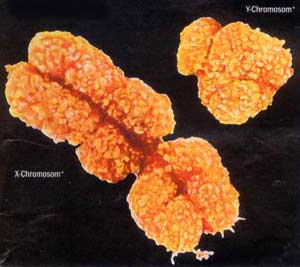Did Conquests and Concubines Spread the Genes of One Man Across China?
 |
|
XY Chromosome Pair |
According to a recent study based on genetic information from the Y chromosome, approximately 1.5 million people in Mongolia and northern China share a common ancestor. Historical data suggests that their common ancestor was a man named Giocangga, who lived in the mid-16th century, and whose descendants founded the Qing Dynasty, which ruled China from 1644 to 1912.
This analysis is reminiscent of a controversial study from 2003, which claimed that nearly 16 million men in China today might be descendants of Genghis Khan.
Similar to the descendants of Genghis Khan, the offspring of Giocangga ruled over a vast steppe and led a royal lifestyle with many wives and concubines. The study published this month in the American Journal of Human Genetics suggests that this was a very effective strategy for maintaining lineage.
“This advantageous breeding strategy may be a more significant genetic characteristic of humans than we have previously recognized,” said Chris Tyler-Smith from the Wellcome Trust Sanger Institute in Hinxton, UK, who led both studies.
The Stability of the Y Chromosome
To demonstrate the reproductive capacity of these conquerors, scientists needed to rely on both historical data and genetic analysis. Most useful information is found in the Y chromosome (which exists in all men), and the Y chromosome tends to be stable.
Other chromosomes easily exchange genetic information with one another. However, during fertilization, the Y chromosome pairs with the X chromosome (which is significantly larger than the Y chromosome), preventing segment exchange between the two chromosomes. This means that the Y chromosome changes very little across generations, making it advantageous for tracing ancestral origins.
In a recent analysis, Tyler-Smith’s team in the UK and China examined the Y chromosome of 1,000 Asian individuals. The comparison of Y chromosome DNA sequences revealed a similarity of about 3.3%. This equivalent genetic information suggests that these individuals share a common ancestor approximately six centuries ago.
To identify the true owner of this Y chromosome, Tyler-Smith revisited historical evidence. They concluded that it was indeed Giocangga.
An aristocratic class inherited genes from Giocangga throughout their reign until 1912. Even lower aristocrats had numerous wives and concubines, which may explain why Giocangga’s Y chromosome is so widely dispersed.
Expanding on Tyler-Smith’s hypothesis, the Manchu soldiers only married within their tribe, and today these groups have the highest rates of Giocangga’s Y chromosome.
Only Genghis Khan’s Y chromosome can be compared to Giocangga’s, with a similarity rate of about 2.5%, according to Tyler-Smith.
The Owner of the Y Chromosome
According to geneticists, obtaining precise information about the origins of the Y chromosome is challenging, and relying on historical evidence can be even less reliable.
“But all geneticists know that we are living fossils,” said Steve Jones of University College London, asserting that the hypothesis regarding Giocangga is not unreasonable. Martin Richards, a geneticist at the University of Leeds, UK, believes that Tyler-Smith’s analysis highlights the origins of the Y chromosome as one of the most reasonable analyses he has encountered.
However, some others disagree. It is too adventurous to assert that it belongs to Giocangga, said Luca Cavalli-Sforza from Stanford. He also suggested that even the studies on Genghis Khan have been overly sensationalized!
Researchers could prove their hypothesis by testing the descendants of Giocangga. But as they say, it’s easier said than done. Although the aristocracy numbered 80,000 in 1912, the Cultural Revolution in the 1960s and 1970s forced all aristocrats to hide their identities to avoid persecution, resulting in the destruction of much information. Several men believed to potentially trace back to the ancestor Giocangga are reluctant to provide DNA samples for researchers.


















































